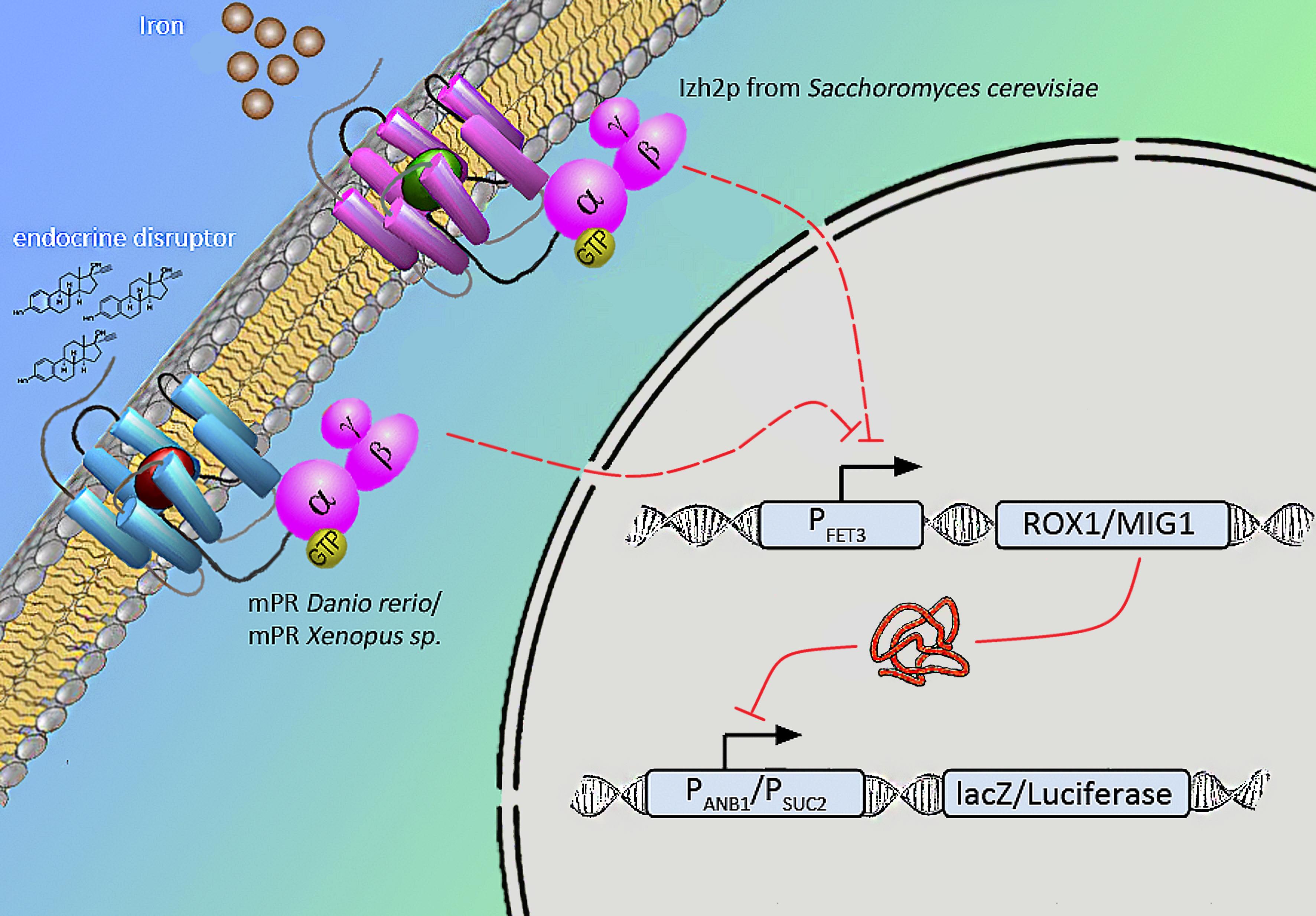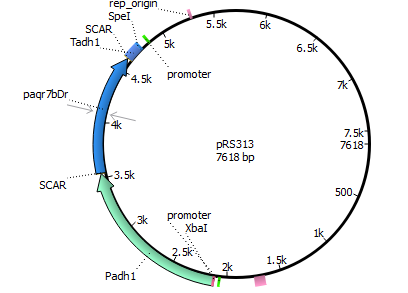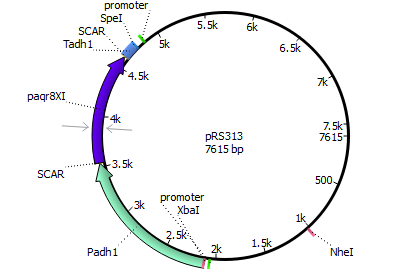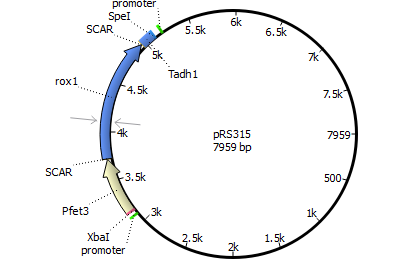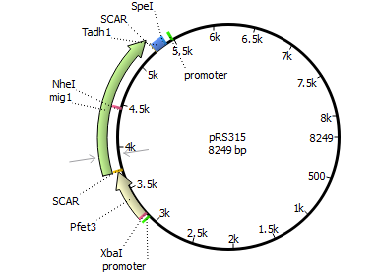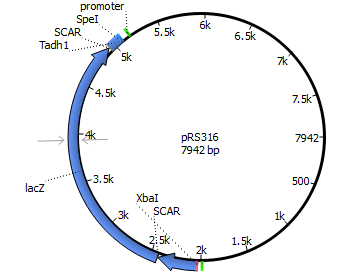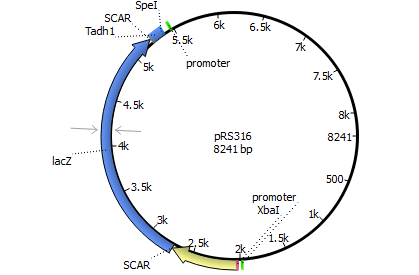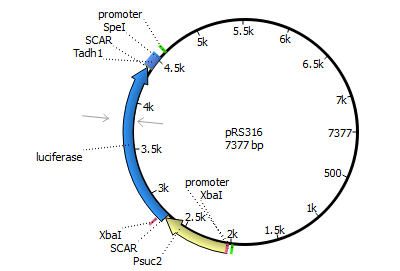Team:Tuebingen/Project
From 2012.igem.org
Jakobmatthes (Talk | contribs) |
|||
| Line 3: | Line 3: | ||
__TOC__ | __TOC__ | ||
| - | == | + | == Overview == |
| - | + | ||
| - | + | Our general aim is to establish a simple synthetic organisim which will | |
| + | be capable to measure the influence of endocrine disruptors on the | ||
| + | natural balance of sexual determination in all kind of vertebrates. The | ||
| + | measurement itself will be cost-efficient, environment-friendly and | ||
| + | sensitive. | ||
| - | We will transform the negative signal | + | Naturally occuring iron receptors of the PAQR family are found to |
| + | repress the fet3 promotor on high level of extra-cellular iron. | ||
| + | According to Smith et al. human mPR expressed in yeast induced the same | ||
| + | signal when binding to progesterone. Relying on this results we will | ||
| + | express various mPRs of Danio rerio and Xenopus laevis in yeast to | ||
| + | measure endocrine substances that influence fish and amphibians. | ||
| + | |||
| + | We will transform the negative signal (fet3 repression) into a positive | ||
| + | signal by regulating a repressor (rox1 or mig1) with Pfet3. This | ||
| + | repressor will in turn regulate the expression of the reporter gene | ||
| + | (firefly luciferase or beta-galactosidase) and allow quantitative | ||
| + | measurement. | ||
== Motivation == | == Motivation == | ||
| Line 14: | Line 28: | ||
''Why do we want to establish a mechanism for steroid measurement?'' | ''Why do we want to establish a mechanism for steroid measurement?'' | ||
| - | Steroid hormones, especially estrogens, occur in all vertebrates and play a crucial role in sexual differentiation. In recent times the pollution of waters with these hormones has become an increasing problem for the aquatic fauna | + | Steroid hormones, especially estrogens, occur in all vertebrates and |
| - | + | play a crucial role in sexual differentiation. In recent times the | |
| + | pollution of waters with these hormones has become an increasing problem | ||
| + | for the aquatic fauna. | ||
| - | + | Particularly waters functionalized by humans or adjacent to human | |
| - | + | settlements, e.g. in areas with agricultural use, show increased | |
| - | + | concentrations of estrogen. | |
| - | + | Scientific studies based on ''Danio rerio'' showed that the consequences | |
| + | are devastating. | ||
| - | + | High concentrations of 17α-ethinylestradiol, a hormone in most | |
| - | + | birth-control pills, affected the sex differentiation of ''Danio rerio'' | |
| - | + | leading to development of ovotestis or complete feminization (Andersenc, | |
| - | + | 2002). | |
| - | + | Intersex-fish have been reported in UK rivers since 1978 downstream of | |
| - | + | an sewage treatment plant. | |
| - | + | ||
| - | + | ||
| - | + | ||
| - | We | + | We believe that a first step in finding a solution to this environmental |
| + | problem is an accurate and reliable method to quantify steroid | ||
| + | concentrations. | ||
| - | + | == Occurring Questions == | |
| - | + | ||
| - | + | ||
| - | + | ||
| - | + | ||
| - | + | On our way designing the major pathway to express a specific reporter | |
| - | + | gene to demonstrate the presence of steroid hormones, we had and still | |
| + | have to deal with several questions concering the choice of BioBricks, | ||
| + | genes and vectors to construct a firm method to determine "pollution" by | ||
| + | steroids. As a conclusion, we have to meet two major requirements for | ||
| + | our system: | ||
| - | + | * It should be as cost-efficient as possible for easy and regular | |
| - | + | application | |
| - | + | * It should be resistant to yeast's own metabolism (Not be disturbed by | |
| + | unexpected occuring expression). | ||
| - | + | At first we had to find an appropriate receptor to "grab" steroid | |
| + | hormones in efluents. This should fulfill the following requirements: | ||
| - | + | * It should only be responsible to substrates we wish to detect, so the | |
| + | results of the test will not be falsified. | ||
| + | * It has to be easiliy integrated into yeast's cell membrane. | ||
| + | * Its nucleic acid sequence should not be too long so we can put it onto | ||
| + | a plasmid vector. | ||
| - | + | We chose the membrane progesterone receptor of zebra fish (''Danio | |
| - | + | rerio'') and of African clawed frog (''Xenophus laevis''). We focused on | |
| + | these receptors, since they are easy to duplicate and interact with a | ||
| + | broad bandwith of sex-determining hormones. | ||
| - | + | The next step was to select an appropriate organism to express these | |
| + | receptors. After some research, we could narrow our options down to two | ||
| + | organisms: | ||
| - | + | * Escherichia coli | |
| + | * Saccharomyces cerevisiae | ||
| - | + | Finally we decided for yeast, since it has been done more research with | |
| + | it according to our prefered receptors. In addition yeast is an | ||
| + | eukaryote making it more easier to integrate mPRs into their cell | ||
| + | membrane. | ||
| - | + | == '''Mechanism''' == | |
| - | + | ||
| - | + | ||
| - | + | ||
| - | + | ||
| - | + | ||
| - | + | ||
| - | + | ||
| - | + | [[File:Igem_2.3.jpg|thumb|right|Planned mechanism]] | |
| - | + | ||
| - | + | ||
| - | + | ||
| - | + | Naturally occuring iron receptors of the PAQR family are found to block | |
| + | FET3 promotor on high level of extra cellular iron. According to | ||
| + | [http://www.ncbi.nlm.nih.gov/pubmed/18603275 Smith JL et al] expressed | ||
| + | human mPR in yeast induced the same signal ligating to estrogen. Relying | ||
| + | on this results we will try to express various mPRs of ''Danio rerio'', | ||
| + | ''Xanophus laevis'' in yeast which we find better fitting to measure | ||
| + | endocrine substances that influence fish. | ||
| - | + | We will transform the negative signal of FET3 by letting it control an | |
| + | inhibitor (ROX1 and MIG1). This inhibitor will regulate the promotor of | ||
| + | our reporter gene. For the promoter of our reporter gene we chose ANB1 | ||
| + | and SUC2, because these are targets of ROX1 and MIG1. By negating the | ||
| + | negative signal of FET3 we hope to obtain a positive signal sensitive | ||
| + | enough to measure low concentrations of different endocrine substances. | ||
| - | + | === Receptors === | |
| - | + | ||
| - | + | Membrane bound, 7-Transmembranereceptor (C-terminus inside,N-terminus | |
| + | outside), PAQR family (progesterone adiponectin Q receptor), Hly-III | ||
| + | superfamily G-Protein coupled: activation of inhibitori Gi units: | ||
| + | reduced adenylyl-cyclase activity. | ||
| - | + | === Inhibitors and their targets === | |
| - | + | An appropriate inhibitor/promotor combination is a crucial step in our | |
| + | pathway and should be selected wisely. | ||
| - | + | Finally we chose FET3 as our promoter and both ROX1 and MIG1 as | |
| + | inhibitors. It is very likely, that they don't seem to repress any gene | ||
| + | expression that are crucial for yeast. | ||
| - | + | === Reporter genes === | |
| + | The last station of our signaling pathway should be a reporter gene | ||
| + | which amplifies our initial signal to allow a quantitative measurement. | ||
| - | + | The enzyme '''luciferase''' fulfills these conditions and is possible | |
| - | + | candidate for our mechanism. | |
| - | + | ||
| - | + | ||
| - | + | == Implementation == | |
| - | + | ||
| - | + | ||
| - | + | === Promoter === | |
[[File:PRS313_Padh1_Danio_Tadh1.png|promoter1]] | [[File:PRS313_Padh1_Danio_Tadh1.png|promoter1]] | ||
| - | |||
[[File:PRS313_Padh1_Xenopus_Tadh1.png|promoter2]] | [[File:PRS313_Padh1_Xenopus_Tadh1.png|promoter2]] | ||
| - | |||
| - | |||
| - | |||
| - | |||
=== Inhibitor === | === Inhibitor === | ||
| - | |||
| - | |||
| - | |||
| - | |||
| - | |||
| - | |||
| - | |||
| - | |||
| - | |||
[[File:PRS315_Pfet3_rox1_Tadh1_V3.png|inhibitor1]] | [[File:PRS315_Pfet3_rox1_Tadh1_V3.png|inhibitor1]] | ||
| - | |||
[[File:pRS315_Pfet3_mig1_Tadh1.png|inhibitor2]] | [[File:pRS315_Pfet3_mig1_Tadh1.png|inhibitor2]] | ||
| - | |||
| - | |||
| - | |||
=== Reporter === | === Reporter === | ||
| - | |||
| - | |||
| - | |||
| - | |||
| - | |||
| - | |||
| - | |||
| - | |||
| - | |||
| - | |||
| - | |||
[[File:PRS316_Panb1_lacZ_Tadh1.png|reporter1]] | [[File:PRS316_Panb1_lacZ_Tadh1.png|reporter1]] | ||
| - | |||
[[File:pRS316_Psuc2_lacZ_Tadh1.png|reporter2]] | [[File:pRS316_Psuc2_lacZ_Tadh1.png|reporter2]] | ||
| - | |||
| - | |||
[[File:PRS316_Psuc2_Luciferase_Tadh1.png|reporter3]] | [[File:PRS316_Psuc2_Luciferase_Tadh1.png|reporter3]] | ||
| - | |||
| - | |||
| - | == | + | == Measurement == |
| + | The measurement itself should be limited to an optical one. With this | ||
| + | idea in mind, we decided for reporter genes like lacZ and luciferase, | ||
| + | because these produce signals which can simply be quantified by optical | ||
| + | measurement methods. | ||
| - | + | == References == | |
| - | + | <!-- | |
| - | + | ||
| - | + | * [1] Jessica L. Smith, Brian R. Kupchak, Ibon Garitaonandia, L. Kim | |
| - | + | Hoang, Andrew S. Maina, Lisa M. Regalla, and Thomas J. Lyons - 2008 - | |
| - | *[1] Jessica L. Smith, Brian R. Kupchak, Ibon Garitaonandia, L. Kim Hoang, Andrew S. Maina, Lisa M. Regalla, and Thomas J. Lyons - 2008 - Heterologous expression of human mPRα, mPRβ and mPRγ in yeast confirms their ability to function as membrane progesterone receptors | + | Heterologous expression of human mPRα, mPRβ and mPRγ in yeast confirms |
| - | *[2] Sumpter, Johnson (2008) Reflections on endocrine disruption in the aquatic environment | + | their ability to function as membrane progesterone receptors |
| - | + | * [2] Sumpter, Johnson (2008) Reflections on endocrine disruption in the | |
| - | *Liew et. al. - 2012 Polygenic Sex Determination System in Zebrafish | + | aquatic environment |
| - | *Hanna et al. - 2006 - Cell-surface expression, progestin binding, and rapid nongenomic signaling of zebrafish membrane progestin receptors alpha and beta in transfected cells | + | * Liew et. al. - 2012 Polygenic Sex Determination System in Zebrafish |
| - | *Reupke - 2011 - Detektion dopingrelevanter anaboler Steroide in Pferdeurin und Pferdeplasma mithilfe eines Reportergen-Assays in Hefezellen. (Detection of doping relevant anabolic steroids in horse urin and blood plasma using yeast reporter gene assays) | + | * Hanna et al. - 2006 - Cell-surface expression, progestin binding, and |
| - | *“Assault on the male”, BBC 1996. Video report http://www.youtube.com/watch?v=LkxIJJI37bQ | + | rapid nongenomic signaling of zebrafish membrane progestin receptors |
| - | *Dr. Volker Scheil, The impact of potential environmental stressors on early development and cellular and biochemical biomarkers in fish, Main research: Fish embryotoxicity, histopathology and stress protein (hsp 70) responses. | + | alpha and beta in transfected cells |
| - | *Harris et al. - 2011 - The consequences of feminization in breeding groups of wild fish | + | * Reupke - 2011 - Detektion dopingrelevanter anaboler Steroide in |
| - | *Liew et al. - 2012 - Polygenic Sex Determination System in Zebrafish | + | Pferdeurin und Pferdeplasma mithilfe eines Reportergen-Assays in |
| - | *Sumpter, Johnson - 2008 - 10th Anniversary Perspective Reflections on endocrine disruption in the aquatic environment from known knowns to unknown unknowns (and many things in between) | + | Hefezellen. (Detection of doping relevant anabolic steroids in horse |
| - | *Werner, Palace, Wautier - 2006 - Reproductive fitness of lake trout (Salvelinus namaycush) exposed to environmentally relevant concentrations of the potent estrogen ethynylestradiol (EE2) in a whole lake exposure experiment | + | urin and blood plasma using yeast reporter gene assays) |
| - | *Fenske, M., Maack, G., Schäfers, C., & Segner, H. (2005). An environmentally relevant concentration of estrogen induces arrest of male gonad development in zebrafish, Danio rerio. Environmental toxicology and chemistry / SETAC, 24(5), 1088-98. Retrieved from http://www.ncbi.nlm.nih.gov/pubmed/16110986 (kein PDF) | + | * “Assault on the male”, BBC 1996. Video report |
| - | *Schäfers, C., Teigeler, M., Wenzel, A., Maack, G., Fenske, M., & Segner, H. (2007). Concentration- and time-dependent effects of the synthetic estrogen, 17alpha-ethinylestradiol, on reproductive capabilities of the zebrafish, Danio rerio. Journal of toxicology and environmental health. Part A, 70(9), 768-79. doi:10.1080/15287390701236470 | + | http://www.youtube.com/watch?v=LkxIJJI37bQ |
| - | *Segner, H., Caroll, K., Fenske, M., Janssen, C. R., Maack, G., Pascoe, D., Schäfers, C., et al. (2003). Identification of endocrine-disrupting effects in aquatic vertebrates and invertebrates: report from the European IDEA project. Ecotoxicology and environmental safety, 54(3), 302-14. Retrieved from http://www.ncbi.nlm.nih.gov/pubmed/12651186 (kein PDF) | + | * Dr. Volker Scheil, The impact of potential environmental stressors on |
| - | *Hanna et al. - 2006 - Cell-surface expression, progestin binding, and rapid nongenomic signaling of zebrafish membrane progestin receptors alpha and beta in transfected cells | + | early development and cellular and biochemical biomarkers in fish, |
| - | *Thomas et al. - 2007 - Steroid and G protein binding characteristics of the seatrout and human progestin membrane receptor alpha subtypes and their evolutionary origins | + | Main research: Fish embryotoxicity, histopathology and stress protein |
| - | *Thomas - 2008 - Characteristics of membrane progestin receptor alpha (mPR ) and progesterone membrane receptor component 1 (PGMRC1) and their roles in mediating rapid progestin actions | + | (hsp 70) responses. |
| - | *Jessica L. Smith, Brian R. Kupchak, Ibon Garitaonandia, L. Kim Hoang, Andrew S. Maina, Lisa M. Regalla, and Thomas J. *Lyons - 2008 - Heterologous expression of human mPRα, mPRβ and mPRγ in yeast confirms their ability to function as membrane progesterone receptors | + | * Harris et al. - 2011 - The consequences of feminization in breeding |
| + | groups of wild fish | ||
| + | * Liew et al. - 2012 - Polygenic Sex Determination System in Zebrafish | ||
| + | * Sumpter, Johnson - 2008 - 10th Anniversary Perspective Reflections on | ||
| + | endocrine disruption in the aquatic environment from known knowns to | ||
| + | unknown unknowns (and many things in between) | ||
| + | * Werner, Palace, Wautier - 2006 - Reproductive fitness of lake trout | ||
| + | (Salvelinus namaycush) exposed to environmentally relevant | ||
| + | concentrations of the potent estrogen ethynylestradiol (EE2) in a | ||
| + | whole lake exposure experiment | ||
| + | * Fenske, M., Maack, G., Schäfers, C., & Segner, H. (2005). An | ||
| + | environmentally relevant concentration of estrogen induces arrest of | ||
| + | male gonad development in zebrafish, Danio rerio. Environmental | ||
| + | toxicology and chemistry / SETAC, 24(5), 1088-98. Retrieved from | ||
| + | http://www.ncbi.nlm.nih.gov/pubmed/16110986 (kein PDF) | ||
| + | * Schäfers, C., Teigeler, M., Wenzel, A., Maack, G., Fenske, M., & | ||
| + | Segner, H. (2007). Concentration- and time-dependent effects of the | ||
| + | synthetic estrogen, 17alpha-ethinylestradiol, on reproductive | ||
| + | capabilities of the zebrafish, Danio rerio. Journal of toxicology and | ||
| + | environmental health. Part A, 70(9), 768-79. | ||
| + | doi:10.1080/15287390701236470 | ||
| + | * Segner, H., Caroll, K., Fenske, M., Janssen, C. R., Maack, G., Pascoe, | ||
| + | D., Schäfers, C., et al. (2003). Identification of | ||
| + | endocrine-disrupting effects in aquatic vertebrates and invertebrates: | ||
| + | report from the European IDEA project. Ecotoxicology and environmental | ||
| + | safety, 54(3), 302-14. Retrieved from | ||
| + | http://www.ncbi.nlm.nih.gov/pubmed/12651186 (kein PDF) | ||
| + | * Hanna et al. - 2006 - Cell-surface expression, progestin binding, and | ||
| + | rapid nongenomic signaling of zebrafish membrane progestin receptors | ||
| + | alpha and beta in transfected cells | ||
| + | * Thomas et al. - 2007 - Steroid and G protein binding characteristics | ||
| + | of the seatrout and human progestin membrane receptor alpha subtypes | ||
| + | and their evolutionary origins | ||
| + | * Thomas - 2008 - Characteristics of membrane progestin receptor alpha | ||
| + | (mPR ) and progesterone membrane receptor component 1 (PGMRC1) and | ||
| + | their roles in mediating rapid progestin actions | ||
| + | * Jessica L. Smith, Brian R. Kupchak, Ibon Garitaonandia, L. Kim Hoang, | ||
| + | Andrew S. Maina, Lisa M. Regalla, and Thomas J. *Lyons - 2008 - | ||
| + | Heterologous expression of human mPRα, mPRβ and mPRγ in yeast confirms | ||
| + | their ability to function as membrane progesterone receptors | ||
| + | |||
--> | --> | ||
Revision as of 11:27, 4 September 2012
Contents |
Overview
Our general aim is to establish a simple synthetic organisim which will be capable to measure the influence of endocrine disruptors on the natural balance of sexual determination in all kind of vertebrates. The measurement itself will be cost-efficient, environment-friendly and sensitive.
Naturally occuring iron receptors of the PAQR family are found to repress the fet3 promotor on high level of extra-cellular iron. According to Smith et al. human mPR expressed in yeast induced the same signal when binding to progesterone. Relying on this results we will express various mPRs of Danio rerio and Xenopus laevis in yeast to measure endocrine substances that influence fish and amphibians.
We will transform the negative signal (fet3 repression) into a positive signal by regulating a repressor (rox1 or mig1) with Pfet3. This repressor will in turn regulate the expression of the reporter gene (firefly luciferase or beta-galactosidase) and allow quantitative measurement.
Motivation
Why do we want to establish a mechanism for steroid measurement?
Steroid hormones, especially estrogens, occur in all vertebrates and play a crucial role in sexual differentiation. In recent times the pollution of waters with these hormones has become an increasing problem for the aquatic fauna.
Particularly waters functionalized by humans or adjacent to human settlements, e.g. in areas with agricultural use, show increased concentrations of estrogen.
Scientific studies based on Danio rerio showed that the consequences are devastating.
High concentrations of 17α-ethinylestradiol, a hormone in most birth-control pills, affected the sex differentiation of Danio rerio leading to development of ovotestis or complete feminization (Andersenc, 2002).
Intersex-fish have been reported in UK rivers since 1978 downstream of an sewage treatment plant.
We believe that a first step in finding a solution to this environmental problem is an accurate and reliable method to quantify steroid concentrations.
Occurring Questions
On our way designing the major pathway to express a specific reporter gene to demonstrate the presence of steroid hormones, we had and still have to deal with several questions concering the choice of BioBricks, genes and vectors to construct a firm method to determine "pollution" by steroids. As a conclusion, we have to meet two major requirements for our system:
- It should be as cost-efficient as possible for easy and regular
application
- It should be resistant to yeast's own metabolism (Not be disturbed by
unexpected occuring expression).
At first we had to find an appropriate receptor to "grab" steroid hormones in efluents. This should fulfill the following requirements:
- It should only be responsible to substrates we wish to detect, so the
results of the test will not be falsified.
- It has to be easiliy integrated into yeast's cell membrane.
- Its nucleic acid sequence should not be too long so we can put it onto
a plasmid vector.
We chose the membrane progesterone receptor of zebra fish (Danio rerio) and of African clawed frog (Xenophus laevis). We focused on these receptors, since they are easy to duplicate and interact with a broad bandwith of sex-determining hormones.
The next step was to select an appropriate organism to express these receptors. After some research, we could narrow our options down to two organisms:
- Escherichia coli
- Saccharomyces cerevisiae
Finally we decided for yeast, since it has been done more research with it according to our prefered receptors. In addition yeast is an eukaryote making it more easier to integrate mPRs into their cell membrane.
Mechanism
Naturally occuring iron receptors of the PAQR family are found to block FET3 promotor on high level of extra cellular iron. According to [http://www.ncbi.nlm.nih.gov/pubmed/18603275 Smith JL et al] expressed human mPR in yeast induced the same signal ligating to estrogen. Relying on this results we will try to express various mPRs of Danio rerio, Xanophus laevis in yeast which we find better fitting to measure endocrine substances that influence fish.
We will transform the negative signal of FET3 by letting it control an inhibitor (ROX1 and MIG1). This inhibitor will regulate the promotor of our reporter gene. For the promoter of our reporter gene we chose ANB1 and SUC2, because these are targets of ROX1 and MIG1. By negating the negative signal of FET3 we hope to obtain a positive signal sensitive enough to measure low concentrations of different endocrine substances.
Receptors
Membrane bound, 7-Transmembranereceptor (C-terminus inside,N-terminus outside), PAQR family (progesterone adiponectin Q receptor), Hly-III superfamily G-Protein coupled: activation of inhibitori Gi units: reduced adenylyl-cyclase activity.
Inhibitors and their targets
An appropriate inhibitor/promotor combination is a crucial step in our pathway and should be selected wisely.
Finally we chose FET3 as our promoter and both ROX1 and MIG1 as inhibitors. It is very likely, that they don't seem to repress any gene expression that are crucial for yeast.
Reporter genes
The last station of our signaling pathway should be a reporter gene which amplifies our initial signal to allow a quantitative measurement.
The enzyme luciferase fulfills these conditions and is possible candidate for our mechanism.
Implementation
Promoter
Inhibitor
Reporter
Measurement
The measurement itself should be limited to an optical one. With this idea in mind, we decided for reporter genes like lacZ and luciferase, because these produce signals which can simply be quantified by optical measurement methods.
 "
"
